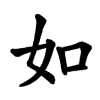Definify.com
Definition 2025
去
去
| ||||||
|---|---|---|---|---|---|---|
Translingual
| Stroke order | |||
|---|---|---|---|

| |||
Han character
去 (radical 28 厶+3, 5 strokes, cangjie input 土戈 (GI), four-corner 40731, composition ⿱土厶)
Derived characters
References
- KangXi: page 164, character 10
- Dai Kanwa Jiten: character 3070
- Dae Jaweon: page 372, character 7
- Hanyu Da Zidian: volume 1, page 384, character 8
- Unihan data for U+53BB
Chinese
|
simp. and trad. |
去 | |
|---|---|---|
| alt. forms |
㚎 弆 |
|
Glyph origin
| Historical forms of the character 去
| |||
|---|---|---|---|
| Oracle bone script | Bronze inscriptions | Large seal script | Small seal script |
 |
 |
 |
 |
| Characters in the same phonetic series (去) (Zhengzhang, 2003) | |
|---|---|
| Old Chinese | |
| 佉 | *kʰal |
| 呿 | *kʰal, *kʰas, *kʰab |
| 抾 | *kʰɯ, *kʰɯ, *kʰab |
| 弆 | *kaʔ, *kʰaʔ |
| 祛 | *kʰa |
| 袪 | *kʰa |
| 阹 | *kʰa |
| 胠 | *kʰa, *kʰas, *kʰab |
| 魼 | *kʰa, *kʰl'aːb |
| 去 | *kʰaʔ, *kʰas |
| 麮 | *kʰaʔ, *kʰas |
| 鼁 | *kʰas |
| 砝 | *kaːb, *kab |
| 劫 | *kab, *kab |
| 鉣 | *kab |
| 蜐 | *kab, *kab |
| 怯 | *kʰab |
Ideogrammic compound (會意) : 大 (“man”) + 口 (“mouth, object”). Top figure simplified to 土, unrelated to 士 (“scholar, gentleman”), while bottom simplified to 厶. There are various interpretations of the combination of “man” and “mouth, object”. One is that the ideograph represented a man with a hole marked in his crotch, and the inventors of writing had perhaps “anus” (i.e. getting rid of) in mind (Schuessler, 2007). Another is that it represented a man departing from a cave or city.
Alternatively, it may be the original character of 呿 (OC *kʰal, *kʰas, *kʰab, “to open one's mouth”), the meaning given by the combination of 大 (“big”) and 口 (“mouth”). The meaning “to depart” would be an extension of the meaning “to open one's mouth”, as the lips depart from each other when one's mouth is open.
Shuowen Jiezi interprets the character as a phono-semantic compound (形聲, OC *kʰaʔ, *kʰas) : semantic 大 (“man”) + phonetic 𠙴.
In addition, 去 is also the original character of 盍 (OC *ɡaːb, “to cover”). The 大 is a cover on top of an object 口.
Etymology
There were two pronunciations in Middle Chinese. The rising tone pronunciation originally meant “to put away, to eliminate” (causative of “to go away”), and the falling tone “to go away, to leave, to depart” (anticausative). The merger of the two pronunciations already happened in Old Chinese and most extant dialects do not observe this distinction now.
This word is of Sino-Tibetan origin with the basic meaning of "to get rid of". Compare Tibetan སྐྱག་པ (skyag pa, “to spend, to lay out; dung, excrement”), རྐྱག (rkyag, “dirt, excrement”), Burmese ကျ (kya., “to fall, to become low”), ချ (hkya., “to put down, to bring down, to lower”).
Pronunciation
- Mandarin
- Cantonese (Jyutping): heoi3
- Hakka (Sixian, PFS): hi
- Min Dong (BUC): kó̤ / ké̤ṳ
- Min Nan
- Wu (Wiktionary): qi (T2); qy (T2)
- Mandarin
- (Standard Chinese, Beijing)+
- Pinyin:
- Zhuyin: ㄑㄩˋ
- Wade-Giles: ch'ü4
- Gwoyeu Romatzyh: chiw
- IPA (key): /t͡ɕʰy⁵¹/
-

- (Standard Chinese, Beijing)+
- Cantonese
- (Standard Cantonese, Guangzhou)+
- Jyutping: heoi3
- Yale: heui
- Cantonese Pinyin: hoey3
- IPA (key): /hɵy̯³³/
- (Standard Cantonese, Guangzhou)+
- Hakka
- (Sixian, incl. Miaoli and Meinong)
- Pha̍k-fa-sṳ: hi
- Hakka Romanization System: hi
- Hagfa Pinyim: hi4
- IPA: /hi⁵⁵/
- (Sixian, incl. Miaoli and Meinong)
- Min Dong
- (Fuzhou)
- Bàng-uâ-cê: kó̤ / ké̤ṳ
- IPA (key): /kʰɔ²¹³/, /kʰøy²¹³/
- Note: ké̤ṳ - "departing tone".
- (Fuzhou)
- Min Nan
- (Hokkien: Xiamen, Zhangzhou, Yilan, Tainan, Kaohsiung, Hsinchu, Taichung)
- Pe̍h-ōe-jī: khì
- Tâi-lô: khì
- Phofsit Daibuun: qix
- IPA (Xiamen): /kʰi²¹/
- IPA (Zhangzhou): /kʰi²¹/
- IPA (Kaohsiung): /kʰi²¹/
- (Hokkien: Quanzhou, Lukang, Sanxia, Kinmen, Hsinchu)
- Pe̍h-ōe-jī: khìr
- Tâi-lô: khìr
- IPA (Quanzhou): /kʰɯ⁴¹/
- (Hokkien: Xiamen, Taipei, Magong)
- Pe̍h-ōe-jī: khù
- Tâi-lô: khù
- Phofsit Daibuun: qux
- IPA (Xiamen): /kʰu²¹/
- IPA (Taipei): /kʰu¹¹/
- Note: khù - suburbs of Xiamen.
- (Teochew)
- Peng'im: ke3 / ku3
- Pe̍h-ōe-jī-like: khṳ̀ / khù
- IPA (key): /kʰɯ²¹³/, /kʰu²¹³/
- Note: ke3 - Chaozhou.
- (Hokkien: Xiamen, Zhangzhou, Yilan, Tainan, Kaohsiung, Hsinchu, Taichung)
- Wu
- (Shanghainese)
- Wiktionary: qi (T2); qy (T2)
- IPA (key): /t͡ɕʰi³⁴/, /t͡ɕʰy³⁴/
- (Shanghainese)
- Dialectal data▼
| Variety | Location | 去 |
|---|---|---|
| Mandarin | Beijing | /t͡ɕʰy⁵¹/ |
| Harbin | /t͡ɕʰy⁵³/ | |
| Tianjin | /t͡ɕʰy⁵³/ | |
| Jinan |
/t͡ɕʰy²¹/ /t͡ɕʰi²¹/ 過~ |
|
| Qingdao | /t͡ɕʰy⁴²/ | |
| Zhengzhou | /t͡ɕʰy³¹²/ | |
| Xi'an | /t͡ɕʰy⁴⁴/ | |
| Xining | /t͡ɕʰy²¹³/ | |
| Yinchuan |
/kʰɯ¹³/ /t͡ɕʰy¹³/ |
|
| Lanzhou |
/t͡ɕʰy¹³/ /t͡ɕʰi¹³/ |
|
| Ürümqi | /t͡ɕʰy²¹³/ | |
| Wuhan |
/t͡ɕʰy³⁵/ /kʰɯ³⁵/ |
|
| Chengdu |
/t͡ɕʰy¹³/ /t͡ɕʰie¹³/ |
|
| Guiyang | /t͡ɕʰi²¹³/ | |
| Kunming |
/t͡ɕʰi²¹²/ ~年 /kʰə²¹²/ ~大理 |
|
| Nanjing |
/kʰi⁴⁴/ /t͡ɕʰy⁴⁴/ |
|
| Hefei | /t͡sʰz̩ʷ⁵³/ | |
| Jin | Taiyuan |
/t͡ɕʰy⁴⁵/ ~哪 /kəʔ²/ 上~ |
| Pingyao | /t͡ɕʰy³⁵/ | |
| Hohhot |
/t͡ɕʰy⁵⁵/ 來~ /kəʔ⁴³/ 吃~ |
|
| Wu | Shanghai |
/t͡ɕʰi³⁵/ /t͡ɕʰy³⁵/ |
| Suzhou | /t͡ɕʰy⁵¹³/ | |
| Hangzhou |
/t͡sʰz̩ʷ⁴⁴⁵/ /t͡ɕʰi⁴⁴⁵/ |
|
| Wenzhou |
/t͡ɕʰy⁴²/ /kʰei⁴²/ |
|
| Hui | Shexian |
/t͡ɕʰy³²⁴/ /t͡ɕʰi³²⁴/ |
| Tunxi | /kʰə⁴²/ | |
| Xiang | Changsha |
/t͡ɕʰy⁵⁵/ /kʰə⁵⁵/ |
| Xiangtan | /t͡ɕʰie⁵⁵/ | |
| Gan | Nanchang | /t͡ɕʰie²¹³/ |
| Hakka | Meixian | /hi⁵³/ |
| Taoyuan | /kʰi⁵⁵/ | |
| Cantonese | Guangzhou | /høy³³/ |
| Nanning | /hy³³/ | |
| Hong Kong | /høy³³/ | |
| Min | Xiamen (Min Nan) |
/kʰu²¹/ /kʰi²¹/ |
| Fuzhou (Min Dong) |
/kʰɔ²¹²/ /kʰœ²¹²/ |
|
| Jian'ou (Min Bei) | /kʰɔ³³/ | |
| Shantou (Min Nan) | /kʰɯ²¹³/ | |
| Haikou (Min Nan) |
/hu³⁵/ /xu³⁵/ |
| Rime | ||
|---|---|---|
| Character | 去 | 去 |
| Reading # | 1/2 | 2/2 |
| Initial (聲) | 溪 (29) | 溪 (29) |
| Final (韻) | 魚 (22) | 魚 (22) |
| Tone (調) | Rising (X) | Departing (H) |
| Openness (開合) | Open | Open |
| Division (等) | III | III |
| Fanqie | 羌舉切 | 丘倨切 |
| Reconstructions | ||
| Zhengzhang Shangfang |
/kʰɨʌX/ | /kʰɨʌH/ |
| Pan Wuyun |
/kʰiɔX/ | /kʰiɔH/ |
| Shao Rongfen |
/kʰiɔX/ | /kʰiɔH/ |
| Edwin Pulleyblank |
/kʰɨə̆X/ | /kʰɨə̆H/ |
| Li Rong |
/kʰiɔX/ | /kʰiɔH/ |
| Wang Li |
/kʰĭoX/ | /kʰĭoH/ |
| Bernard Karlgren |
/kʰi̯woX/ | /kʰi̯woH/ |
| Expected Mandarin Reflex |
qǔ | qù |
| Baxter-Sagart system 1.1 (2014) | ||
|---|---|---|
| Character | 去 | 去 |
| Reading # | 1/2 | 2/2 |
| Modern Beijing (Pinyin) |
qù | qù |
| Middle Chinese |
‹ khjoX › | ‹ khjoH › |
| Old Chinese |
/*[kʰ](r)aʔ/ | /*[k]ʰ(r)ap-s/ |
| English | get rid of | depart |
Notes for Old Chinese notations in the Baxter-Sagart system: * Parentheses "()" indicate uncertain presence; | ||
| Zhengzhang system (2003) | ||
|---|---|---|
| Character | 去 | 去 |
| Reading # | 1/2 | 2/2 |
| No. | 10684 | 10687 |
| Phonetic component |
去 | 去 |
| Rime group |
魚 | 魚 |
| Rime subdivision |
0 | 0 |
| Corresponding MC rime |
去 | 㰦 |
| Old Chinese |
/*kʰaʔ/ | /*kʰas/ |
Definitions
去
- to go to; to go away; to leave; to depart
- (before or after a verb) to go in order to do something
- to remove; to get rid of
- (between two verbs) to; in order to
- Particle used after a verb of motion to indicates movement away from the speaker.
- to send; to dispatch
- to play (a part, a character); to act
- last; past
- 去年 ― qùnián ― last year
- Short for 去聲/去声 (qùshēng).
- (neologism) what the ****; what; damn; ****
- 我去 ― wǒqù ― what the ****
Compounds
|
|
|
Japanese
Kanji
- to leave, to go away
Readings
Compounds
See also
Korean
Hanja
去 • (geo) (hangeul 거, revised geo, McCune-Reischauer kŏ)
- This term needs a translation to English. Please help out and add a translation, then remove the text
{{rfdef}}.
Vietnamese
Han character
去 (khứ, khử)
- This term needs a translation to English. Please help out and add a translation, then remove the text
{{rfdef}}.